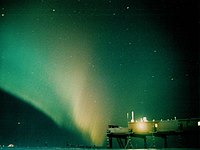The Halley Research Station is a British research base run by the British Antarctic Survey. It mainly researches atmospheric sciences, but also survey, geology and glaciology. It was founded in 1957.
The Science
 |
| Halley V, winter 98 |
Halley, lying within the auroral zone, is ideally situated for geospace research. And during the 105 days every year that the sun does not rise above the horizon, there are frequent displays of the Southern Lights (Aurora Australis)
It was at Halley base in 1985, that scientists first recorded ozone depletion of the Antarctic stratosphere. It was these research that prompted the ban on CFC's. Scientists at Halley continue to monitor the ozone and atmospheric pollution. They have a special lab called CASlab (Clean Air Sector lab) which is located 1km from Halley VI. Scientists that work at the lab have to walk or ski there so that they don't contaminate the area with pollution from vehicles. And when working there, they have to wear special protective suits so that their bodies and breath don't contaminate any of the work they are doing.
The Bases
There have been 6 bases over the years due to the harsh climate and ice movement. The main problem being that the base would be buried and crushed under snow. During winter months, the base would experience meters worth of snow build up.
Halley I started out as a simple collection of huts. At the end of each winter, the huts would be buried or partially buried under snow, and new huts built, expanding the base into a multi-story structure buried under snow. Its was abandoned in 1986, by which time it was buried under 14 meters of snow and ice, and the temperature of the living and sleeping quarters had dropped to -18oC. Halley II had to be abandoned after only 7 years because it too was buried too deep.
Another problem was that the base is located on the Brunt Ice Shelf which is floating on the Weddell Sea. As the ice shelf moves out to sea, pushed by the glacier, chunks break off (this is called 'Calving') and float out into the Weddell Sea as icebergs. Each year, the buildings drift about 0.5km north west. Halley III had been specially designed to cope with snow build up. It was a special underground base. But it was abandoned after 12 years because it was getting just too deep to access safely. Many years later, it reemerged at the edge of the ice shelf as a calving iceberg broke it in half.
|
|
Halley V, completed in 1992, was a revolutionary design. The base was built on stilts, and could be moved up above the snow accumulation. This greatly improved living and working conditions, and meant that the base had a longer life. The base could not be buried under snow or crushed under its weight. However, it didn't stop the problem of the moving ice shelf.
A special competition was held to design a new Halley base. The base had to survive the harsh winter and the moving ice as well as minimising the environmental impact of the station. The winning design took 4 years to build, and Halley VI became an operational station in 2012. This new base was built on stilts, just like Halley V. But this time, the stilts all had skis on the bottom. This means that the station can always remain a safe distance from the edge of the ice shelf. The central red module contains the communal areas for dining, relaxation etc., while the blue modules provide accommodation, laboratories, offices, generators, an observation platform and many other facilities. Halley V uses the latest technology in minimising its environmental impact. It has bio-reactors for treating sewage. And two-stage incinerators for burning some types of rubbish. There are also solar panels that take advantage of the 24 hour sunlight during the summer months.
You can check whats going on at Halley VI right now by going to their webcam.
And you may wanna check out this really good article.
And you may wanna check out this really good article.




